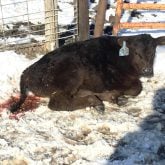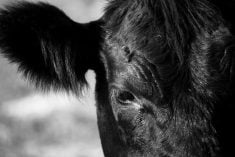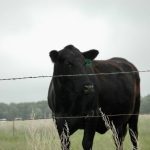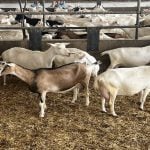I turned on the TV a week ago to watch what’s going on south of the border. After taking in the political news, the next channel I turned to relayed the sad story of a young couple with around 300 cows and a horrible outbreak of cryptosporidiosis during their calving season, the treatment nightmare of up to 40 calves at a time on IV fluids, the mortality and the fact one of their children contacted crypto. Their realization that cryptosporidium could be causing a zoonotic disease added to the exhaustion of getting on top of that year’s wreck and pondering what the next year could possibly bring.
Infection with cryptosporidium presents a serious numbers game. It takes only a few parasites — as few as 20 — to elicit infection in newborn calves. At the height of an outbreak, calves excrete tens of millions of infective agents each day. Cryptosporidiosis, also known as “crypto,” is easily transmitted to people.
Scours caused by cryptosporidium is age-dependent, almost exclusively affecting calves between a week and six weeks old. Older calves are more resistant to clinical disease but can still shed the organism in their manure (asymptomatic carriers). Animals shedding oocysts range from those that shed very few to the “super-shedders.” Unfortunately, there are still no effective, approved antimicrobials to treat cryptosporidiosis in calves or vaccines. Decoquinate, an anticoccidial used in poultry, has shown some effectiveness.
Read Also

Building demand together: The impact of Canada’s beef import levy
The beef import levy has become a central tool for ensuring balance in Canada’s beef industry
Crypto is a disease of young calves caused by a protozoan parasite, Cryptosporidium parvum or C. parvum. Clinically, C. parvum produces profuse, watery diarrhea that can lead to dehydration and death without fluid replacement.
Humans may acquire C. parvum from infected calves and have watery diarrhea lasting up to three weeks. Crypto can be life-threatening in immunocompromised individuals and is often diagnosed in AIDS patients.
Cryptosporidium oocysts are thick-walled, resembling parasite eggs, that are passed in the feces of infected calves and cows. Adult cattle are generally non-clinical carriers. Oocysts are spread between calves by the fecal-oral route, either directly through contact with feces from infected calves, as might be the case with dirty udders, or indirectly by ingestion of feces-contaminated feed or water. Following ingestion of oocysts by the calf, the organism begins a very complex reproductive cycle.
The conditions inside the small intestine (low pH and lower body temperature) trigger the oocyst to hatch, releasing four sporozoites that invade cells lining the intestine where they again divide. The newly formed oocysts are of two different types: thin-walled oocysts that stay inside the gut and keep infecting new cells, or thick-walled oocysts which are passed in feces and immediately infect other calves. The ability to produce thin-walled oocysts, which are retained in the gut to infect other cells of the small intestine, is one of the reasons why the cryptosporidium parasite is so successful. “Self-infection” means the parasite rapidly produces oocysts in a relatively short time.
The thick-walled oocysts are released in feces and can survive for months in cool, moist climates. They are resistant to many disinfectants. A neonatal calf can shed 30 billion oocysts over one to two weeks but it only takes 10-30 oocysts to cause new infections. Livestock (cattle and sheep) and wildlife (deer) can share the same genotype of C. parvum so transmission can occur between livestock and wildlife.
Another feature of crypto is the fact it can be part of an etiological cocktail that includes other disease agents responsible for scours in young calves. This includes pathogens such as coccidiosis, coronavirus, rotavirus, E. coli and salmonella. Considering these pathogens and determining whether they may play a part in initiating an outbreak of scours becomes a critical consideration in shaping strategies for next year. Things worth considering are suppression of coccidia oocysts by cows before calving through feeding anticoccidials; vaccination of cows for rotavirus, coronavirus and E. coli; good colostrum management; and keeping things clean and dry. Consider calving on pasture and moving cows that have not calved several times through calving season (an example is the Sand Hill calving system).
Cryptosporidium parvum has been found in 65-97 per cent of rivers, lakes and other surface water sources tested in the U.S. Milwaukee, Wisconsin, reported the largest outbreak in history. In the spring of 1993, a waterborne outbreak infected about 403,000 people. A similar, but smaller-scale outbreak occurred in the U.K. in 1999 after infected sheep contaminated a reservoir in England that supplied the city of Manchester and county of Lancashire. North Battleford reported roughly 700 people ill in 2001 during a tainted water scandal when a raw sewage leak contaminated river water above the city’s fresh water intake. The Saskatchewan government and the city of North Battleford paid out $3.3 million to people under the age of 18 at the time they consumed contaminated drinking water. Outbreaks have also been associated with public swimming pools.
The bottom line is that current water treatment guidelines (e.g. chlorination levels, etc.) were largely designed to eradicate coliforms. Cryptosporidium parvum is not sensitive to chlorination.
My heart went out to the young couple who struggled with the crypto problem and the courage it took to talk about it. I sincerely hope their youngster recovered. I can’t sign off without offering encouragement to the veterinarians involved, and how difficult it can be when answers are hard to find.
Dr. Ron Clarke prepares this column on behalf of the Western Canadian Association of Bovine Practitioners. Suggestions for future articles can be sent to Canadian Cattlemen or the WCABP.

















